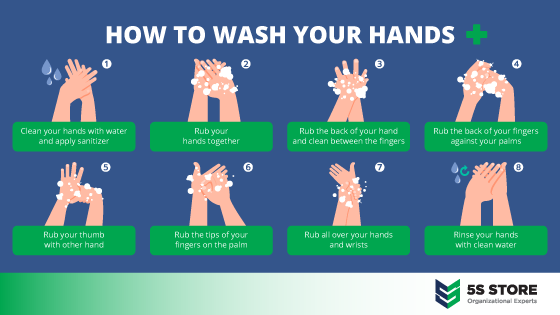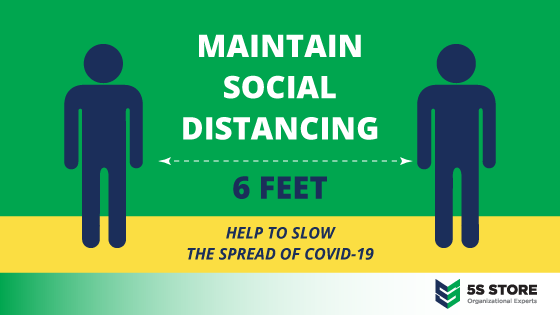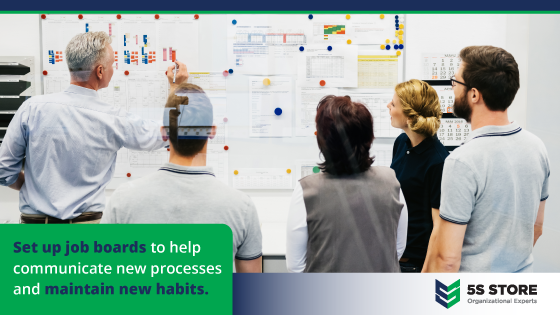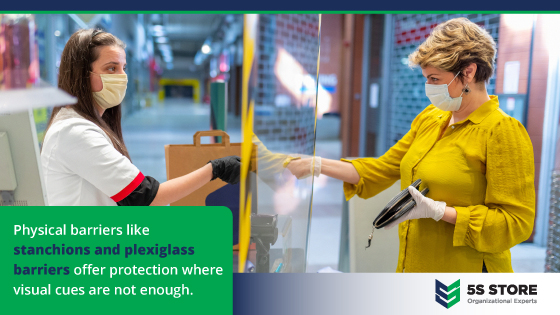
How to Get Back to Work Safely: 6 Best Practices from 5S That Are Essential Now
An earlier version of this post was published on LinkedIn on May 4th, 2020.
Our world has changed. Maybe for a moment, maybe forever. We don’t know what the future holds yet. Nevertheless, many of us are heading back to work in warehouses, factories, and office buildings all over the country. How to get back to work safely is on the top of our minds.
The coronavirus pandemic added both a new word and a new awareness that we carry with us as we leave our homes for work.
Social Distancing…
A few months ago, we might have a vague association of this term with the famous recluse Howard Hughes or perhaps a certain 1970s-era John Travolta film based on the true story of David Vetter. Today, it’s our moment-to-moment reality. As the world opens back up again, post-lockdown, a heightened awareness of physical space has become of paramount importance.
For businesses, the new reality means an added focus on things that can help keep their environment safe for both employees and customers. Even on television commercials, we see this coming to life. Every other mid-sitcom break seems to be a commercial for touchless takeout or curbside delivery.
For the majority of my career, I’ve been a a student of the 5S Methodology.
The 5S system is a step-by-step way to transform a space from disorder and clutter to clean and organized. It’s a methodology made for this moment.
As a 5S expert, it occurs to me that many of the methods and solutions that are used in our world every day are important to this moment. Even if you don’t use or plan to use the whole system, several of the tenants are useful to help you understand how to get back to work safely as stay-at-home orders are lifted.
Below are some of the 5S best practices you might want to consider employing to help support social distancing and cleaning standards for your facility. I, and the whole team at The 5S Store, hope they help you get back up and running as quickly as is safely possible.
Six 5S Best Practices to Help You Get Back to Work Safely
1. Use visual aids to cue important behaviors like handwashing.

Clear and concise communication is a major tenant of 5S. Visual cues are fantastic reminders to help create new habits and trigger the right behaviors. Signs, posters, and banners can all be used to help with new or repetitious activities. Use visual aids for activities such as:
- Supporting social-distancing between workers,
- Keeping people out of designated areas,
- Reminding employees to wash their hands,
- Reminding employees to use PPE equipment.
Install safety signage with social distancing messaging throughout your facility to keep everyone up-to-date and remind them about requirements. And, use fold-up signs to provide immediate and flexible messaging where you need it. These types of visual communication are particularly useful when you’re trying to guide people in a different direction than they may be used to.
Signage is the simplest and fastest way to provide visual cues. The next tool, you’ve probably seen popping up in your local grocery store or pharmacy… floor marking.
2. Floor tape and floor signs help cue social distancing, especially in highly trafficked areas.

Floor marking is a way of life in 5S. Using floor tape and signs to keep traffic and items in their appropriate places. For social-distancing, floor cues help us to ensure that people follow the six-feet (or more) distancing guidelines and do not wander into areas where they are prohibited from being.
Floor marking goes way beyond just tape put on the floor. Use any of these to help provide guidance:
- Adhesive footprints,
- Arrows,
- Stop signs.
The great thing about adhesive floor markings is that they provide flexibility. You can change them easily when things change.
It is critical to make sure that the message you’re sending is concise and easy to understand. For example, if you’re a company who requires people to stand in lines, mark the places to stand clearly. Use footprints or corner markers to indicate where people should stand, making sure they are six feet apart. Further, add adhesive floor signs that explain the need to maintain the distance.
Companies with employees at workstations, like on an assembly line, will want to employ the same approach to indicate what proper distancing between workstations looks like.
Beyond social-distancing, it is important to be vigilant about our cleaning standards. That’s where the next tool from the 5S toolbox comes in, color-coded cleaning tools.
3. Color-Coded cleaning tools help prevent cross-contamination.
In the 5S world, color-coded cleaning tools are used to keep tools in their place. For the sake of today’s cleaning standards, you can use these tools to help eliminate the spread of germs. Using specific colors for a particular department or area will help to prevent cross-contamination. For example, using blue barrels, brooms, wet mops, and brushes for the warehouse, and a set of green ones for the manufacturing floor.
Consider using tool shadow boards with a background color scheme chosen for that department to make the message even more clear and keep tools organized and in their proper location. That way, each tool has its place and you know when a tool goes missing.
Tool shadow boards are useful for organizing and maintaining standards; and, there’s another type of board useful for all the new habits we’re asking our employees to learn now…Job boards.
4. Set up job boards to help communicate new processes and maintain new habits.

Most of us are implementing new processes at this moment in some way. Whiteboards, rotating communication towers, and/or hanging binders used as task boards help employees to keep up with habits. Use these tools to track pending and completed cleaning tasks at your workplace.
When visual cues and communication are not enough, there are two more tools in my toolbox to take things further, physical barriers and mobile workstations.
5. Physical barriers like stanchions and plexiglass barriers offer protection where visual cues are not enough.

Stanchions are a great tool for directing the flow of materials or people traffic. They’re completely mobile, which helps to provide flexibility. Signs can be added to the tops of the stanchion for further explanation, as needed.
For customer-facing employees or facilities where six-feet spacing isn’t possible, plexiglass barriers are essential, offering complete protection of the spread of germs while also allowing visibility..
Just like our personal space is evolving, so too is our teamwork. Learning how to get back to work safely on a team is a new frontier for many of us.
6. Use mobile workstations to keep workers productive and safely distanced from their co-workers.
Workers that used to work in teams or at common workstations may now require their own workstations. Use mobile workstations to keep workers productive and safely distanced from their co-workers. Many come battery-powered, allowing you to locate them in places that may not have wiring. And, they have space for personal printing, scanning, and computing.
It is my hope that, with these tools, many of us will get back to work safely and quickly – and stay there.

